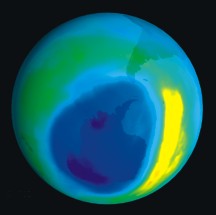geotimesheader
News
Notes
| Olympic
ozone loss
On Sept. 10, the area of the Antarctic ozone hole
set a new record as the largest such area ever observed. The ozone “hole”
extended 29.7 million square kilometers, overtaking the previous record
of 27.2 square kilometers on Sept. 19, 1998, says Paul A. Newman, an atmospheric
physicist at NASA’s Goddard Space Flight Center.
Early spring conditions stimulated the dramatic
ozone loss. Ozone’s annual low in the Antarctic region usually coincides
with the commencement of spring in the Southern Hemisphere in late September
or early October. Very cold temperatures and weaker weather systems in
the stratosphere contributed to this year’s extensive ozone loss. |

The ozone depletion area on
Sept. 10. NASA. |
These factors increased the area enclosed by the
Antarctic vortex, a jet stream that circles the Antarctic region and isolates
it from the mid-latitudes and tropics, thereby increasing the area affected
by ozone loss.
“We know that the meteorology this year is different
from the last few years, and that this has led to this bigger ozone hole,”
Newman says. “But we don’t know why. It’s either natural variability or
climate change. If it’s climate change we need to be worried.”
The major factor in ozone depletion rates is the
continued presence of ozone-destroying gases such as chlorofluorocarbons
in the stratosphere.
Despite international restrictions on the production
of ozone-destroying gases, says manager Michael Kurylo of NASA’s Upper
Atmospheric Research Program, the lifetimes of the gases will allow them
to destroy ozone for many decades to come.
Bridget K. Mulvey
Geotimes
contributing writer

